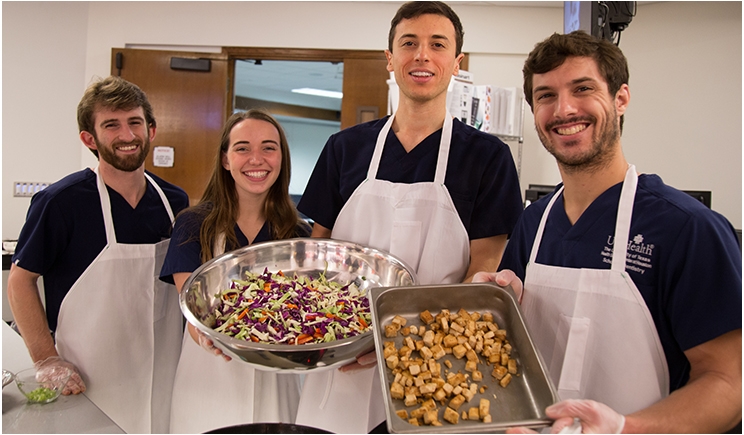
Students at the University of Texas Health Science Center at Houston (UTHealth) School of Dentistry are learning how to do more than drill and fill. They’re also in the kitchen, learning how to prepare nutritious and delicious meals that benefit oral and systemic health alike thanks to the Nourish Program at the UTHealth School of Public Health.
“It is a hands-on nutrition education course where we teach students how to make healthy food taste good,” said nutritionist supervisor John Wesley McWhorter, MS. “We teach disease specifics, whether it be obesity, diabetes, heart disease, et cetera. We do case studies. We talk about the patients, and then we design food around what those patients should be eating.”
Launched this fall, the eight-week Culinary Dentistry pilot program targets second-year dental students. Each week, these students spend an hour online in preparation. When they get to class, there are lectures, discussions, and quizzes before they go into the kitchen to prepare that week’s recipes. After that, it’s time to share their dishes and talk about the results.
“We work through the case study, and then we go into the kitchen and prepare recipes based on the patient’s preferences. And then we come back into the classroom, eat the food, and then describe how it can help the types of oral issues that may arise. How can we refer the patient? How do you talk to a dietitian about what’s going on?” McWhorter said.
The fall session of the course covers two hypothetical patients, one diabetic and one obese, for its case studies. Students learn about these patients’ diet and medical history as well as their culture, employment, and socioeconomic background, which play an often overlooked role in why these patients eat what they do, with the goal of changing their behavior.
“It doesn’t matter if you tell everybody to eat their vegetables. If they aren’t actually eating them, it does no good. Less than 10% of the adult population eats the amount of vegetables they should every day, which is a big problem,” said McWhorter. “So we do small behavioral modifications to get people closer to the target.”
For example, many of the dishes in the class minimize or eliminate added sugars, which cause tooth decay as well as obesity and diabetes. Sugar-sweetened beverages are addressed as well, since their acids also are a culprit behind tooth erosion. Discussion topics include food labeling, hidden sugar, simple carbohydrates, and how such factors all must be minded in a recipe.
Dishes have included cucumber yogurt Tzatziki sauce, parmesan eggplant fries with marinara dipping sauce, Indian cabbage stir fry, carrot top pesto, garden penne with ground beef, sweet potato chips, and pumpkin pie spiced kale smoothies. A recent Halloween celebration included stuffed peppers carved like jack-o-lanterns and “graveyard” chocolate hummus.
“Chocolate hummus is a play on brownie batter chocolate dip. It is a bean spread that is turned into a chocolate dip. That’s a good one to talk to the students about because it still has a little bit of added sugar in it, but the benefit is that it has a mixture of protein fiber and fat, so that helps protect the teeth but also gives the patient something they enjoy,” said McWhorter.
The class is designed to be collaborative, too. There are 20 dental students in the class divided among five tables. A dietetic intern who acts as a co-teacher and assists during cooking is stationed at each table as well. Each table prepares two recipes, with two tables preparing snacks, and one each preparing breakfast, lunch, and dinner.
“It’s not just ‘Let’s go cook some food and drink some wine.’ It’s a learning environment,” McWhorter said. “When they get done cooking, we set up buffet style, and we all make a plate, sit down, and discuss what works and what doesn’t work. ‘I don’t like this flavor.’ ‘What would you do differently?’”
Feedback from the students has been positive so far, with many students praising its hands-on approach to learning. Students also enjoy the class’ collaborative and interdisciplinary environment. Of course, they like the food too, which often features fresh ingredients grown right in the program’s garden outside the classroom and kitchen.
“It’s not just teaching someone in a lab. It’s really showing them how to do it. I think that’s what they’re really enjoying. And to be honest, it’s a break from their normal activities. It’s a fun environment. You’re getting to cook. They’re learning a lot about ‘Hey, I should do this. This is healthier,’” McWhorter said.
Looking ahead, the school hopes to expand its material and add another module to cover more topics. There also may be more online material so more content could be covered ahead of time, leaving students more prepared and giving them more time for hands-on work in the classroom and kitchen. Dental students may work with the artificial patient simulator as well.
Beyond the classroom, McWhorter and the rest of the faculty hope the students will carry the impact of nutrition on oral health and systemic health into their careers, keeping these lessons in mind in diagnosing patients and developing treatment plans that may include dietary and behavioral components.
“One of the biggest takeaways I want the students to have is to recommend what we know is true and right, which is a balanced plate, and then to refer out,” McWhorter said. “You could refer them to a dietitian. You could refer them for a medical consult. And I think that needs to occur more often so we can start treating chronic diseases like diabetes and obesity.”
Related Articles
Culinary Dental Classes Get Into the Holiday Spirit
Good Nutrition Has Positive Impact on Periodontal Health
A Healthy Diet Tames Gingivitis in Just Four Weeks











